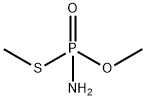메타미도포스 C화학적 특성, 용도, 생산
화학적 성질
Methamidophos is a colourless crystalline solid with a pungent odour. It is readily soluble in water, alcohols, ketones, and aliphatic chlorinated hydrocarbons but sparingly soluble in ether and practically insoluble in petroleum ether. Methamidophos is also a breakdown product of another OP, namely, acephate. Methamidophos is slightly corrosive to mild steel and copper alloys.
용도
Methamidophos is used to control a wide range of insects and
mites in a very large number of crops.
일반 설명
Crystalline solid, technical product is off-white with a pungent odor. Used as an insecticide on a number of vegetables and on cotton.
반응 프로필
Organophosphates, such as Methamidophos, are susceptible to formation of highly toxic and flammable phosphine gas in the presence of strong reducing agents such as hydrides. Partial oxidation by oxidizing agents may result in the release of toxic phosphorus oxides. Avoid strong acids or alkalis. [EPA, 1998].
건강위험
Methamidophos is harmful or fatal if swallowed, inhaled, or absorbed through the skin.
화재위험
(Non-Specific -- Organophosphorus Pesticide, n.o.s.) Container may explode in heat of fire. Fire and runoff from fire control water may produce irritating or poisonous gases. (Non-Specific -- Phosphoramidothioic Acid, O-Ethyl S-Methyl Ester) Emits very toxic fumes of nitrogen oxides, phosphorus oxides, and sulfur oxides when heated to decomposition. Stable at neutral pH. Avoid strong acids or alkalis.
농업용
Insecticide, Miticide: Methamidophos is a highly active, systemic, resid-ual organophosphate insecticide/acaricide/avicide with
contact and stomach action. Its mode of action in insects
and mammals is by decreasing the activity of an enzyme
important for nervous system function called acetylcholinesterase. This enzyme is essential in the normal transmission of nerve impulses. Methamidophos is a potent
acetylcholinesterase inhibitor. It is effective against chewing and sucking insects and is used to control aphids,
flea beetles, worms, whiteflies, thrips, cabbage loopers,
Colorado potato beetles, potato tubeworms, armyworms,
mites, leafhoppers, and many others. Crop uses include
broccoli, Brussels sprouts, cauliflower, grapes, celery,
sugar beets, cotton, tobacco, and potatoes. It is used abroad
for many vegetables, hops, corn, peaches, and other crops.
Generally, methamidophos is not considered phytotoxic
if used as directed, but defoliation has occurred when applied as foliar spray to deciduous fruit. It is compatible
with many other pesticides, but do not use with alkaline
materials. Methamidophos is slightly corrosive to mild
steel and copper alloys. This compound is highly toxic to
mammals, birds, and bees. Do not graze treated areas, and
be sure to wear protective clothing including respirator,
chemical goggles, rubber gloves, and impervious protective clothing. A U.S. EPA restricted Use Pesticide (RUP).
Not approved for use in EU countries
.
상품명
ACEPHATE-MET®; BAY 71625®; BAYER
71628®; CHEVRON 9006®; CHEVRON ORTHO 9006®;
FILITOX®; GS-13005®; HAMIDOP®; METAFOS®;
MONITOR®; MTD®; NITOFOL®; NURATRON®;
ORTHO 9006®; PATROLE®; PILLARON®; SRA
5172®; SUPRACIDE®; SWIPE®; TAHMABON®;
TAMARON®; VITARON®
Safety Profile
Poison by ingestion,
inhalation, sh contact, subcutaneous, and
intraperitoneal routes. Human systemic
effects by ingestion: fasciculations, pupdlary
constriction, and sweating. A cholinesterase
inhbitor type of insecticide. When heated to
decomposition it emits very toxic fumes of
NOx, POx, and SOx. See also
PARATHION.
잠재적 노출
A potential danger to those involved
in the manufacture, formulation, and application of this
insecticide on vegetables and cotton
환경귀착
Chemical/Physical. Emits toxic fumes of phosphorus, nitrogen and sulfur oxides when
heated to decomposition (Sax and Lewis, 1987).
신진 대사 경로
Methamidophos is a contact insecticide which is particularly effective
against caterpillars and aphids. It also has some systemic action although
much less than acephate. There is some uncertainty concerning the nature
of the leaving group when the compound inhibits acetylcholinesterase
although most evidence suggests that it is methanethiolate. There are
claims that it requires metabolic activation to a more active inhibitor (Eto
et al., 1977) and yet other evidence that it does not (Khasawinah et al.,
1978). Most studies which have examined the biotransformation of
acephate have identified methamidophos as one of its metabolites and the
latter is considered to be the active metabolite. The main route of biotransformation
in soil is through deamination. In mammals, metabolism
involves de-O-methylation, de-S-methylation and deamination, with de-
O-methylation in the liver probably being the most important route.
There is no evidence as to whether demethylation is hydrolytic or oxidative.
Methamidophos and its metabolites are highly polar and no conjugates
have been identified. There is some evidence that the compound
can lead to delayed neurological degeneration in mammals through
inhibition of 'neuropathy target esterase'.
신진 대사
Acute oral LD
50 for rats is about
20 mg/kg. Inhalation LC50 (4 h) for rats is 0.2 mg/L
air. NOEL (2 yr) for rats is 2 mg/kg diet (0.1 mg/kg/d).
ADI is 4 μg/kg b.w. Methamidophos itself shows only
a poor anti-AChE activity, oxidative activation being
suggested. It appears to cause delayed neuropathy.
The major part of administered methamidophos in
animals is rapidly eliminated from the body through
urine and respiration. The major metabolic routes are
O-demethylation, S-demethylation, and deamination. In
plants, deaminated methamidophos is a major metabolite.
Methamidophos is degraded rapidly in soil by deamination
and demethylation, to eventually form carbon dioxide and
phosphoric acid.
운송 방법
UN2783 Organophosphorus pesticides, solid,
toxic, Hazard Class: 6.1; Labels: 6.1-Poisonous materials
비 호환성
Incompatible with strong acids or alkali.
Attacks mild steel and copper-containing alloys (technical
grade)
폐기물 처리
In accordance with 40CFR
165 recommendations for the disposal of pesticides and
pesticide containers. Must be disposed properly by following package label directions or by contacting your local or
federal environmental control agency, or by contacting
your regional EPA office.
메타미도포스 준비 용품 및 원자재
원자재
준비 용품








